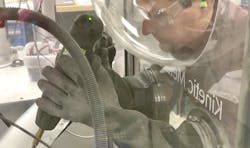The Rise of Cold Spray Technology at Fleet Readiness Center Southwest
By Janina Lamoglia, Fleet Readiness Center Southwest
NAVAL AIR STATION NORTH ISLAND, Calif. -- At the Fleet Readiness Center Southwest (FRCSW), a team of dedicated engineers is pioneering the use of cold spray technology. This innovative approach is not only enhancing the repair capability for aging aircraft but also paving the way for substantial cost savings, an increase in readiness, and environmental benefits.
Luc Doan, a Senior Materials Engineer with nearly three decades at FRCSW, alongside fellow F/A-18 Senior Engineer Conrad Macy and Materials Engineers Stoney Middleton and Matthew Chu spearheaded this initiative.
Cold spray, a subset of thermal spray technologies, stands out for its unique method of depositing metallic powder. Unlike other thermal techniques that rely on heating the powder to its melting point, cold spray propels the metal powder at high velocities, creating a solid-state process without the need for melting. This technique creates a metallurgical bond with the substrate, resulting in a robust and durable repair.
What distinguishes FRCSW in this field is not just the technology itself but also the scale and sophistication of its implementation. The Materials Engineering Department boasts an array of cold spray and ancillary equipment, including multiple low-pressure cold spray systems manufactured by Centerline and Inovati as well as a high-pressure VRC cold spray system, which has just been added to FRCSW’s repair toolbox. These systems are capable of both handheld and robotic spray operations. Handheld spraying accounts for over half of their repairs. This capability has led to over 35 approved repairs and the restoration of 400 parts, a testament to the technology's growing significance in maintaining and extending the life of naval aircraft. None of the Cold Spray-repaired parts has returned to the depot because the repair failed in service. That means the technology is working.
Introduced to FRCSW in 2009, cold spray technology was initially used in partnership with original equipment manufacturers, academia, and other partners. Macy, a Fleet Support Team Engineer, was instrumental in recognizing the potential of the Cold Spray technology to repair corrosion and wear damage. He implemented it to repair the low in-supply, long lead-time, and high-value F/A-18 Aircraft Mounted Auxiliary Drive (AMAD) gearboxes. A year later, the first NAVAIR Cold Spray repair was approved for the Super Hornet AMAD Hydraulic Pad with fretting damage. The first AMAD was repaired and returned to the supply system in February 2011 and installed on a Super Hornet in May 2011. To date, 35 AMADs have been repaired by Cold Spray comprising an asset that has over 24,500 flight hours as of May 2023.
The success of cold spray hinges on the skilled artisans who undergo rigorous training and certification to master this technique. A Job Qualification Requirement (JQR) was established in 2020 that contains classroom and on-the-job trainings for cold spray artisan certification. The benefits of cold spray extend beyond the technical prowess it provides. It represents a shift in maintenance philosophy, moving away from traditional methods like adhesives, sealants, and paints for blend-and-fill repairs. These hazardous materials are less corrosion and wear resistant, and pose environmental risks as well as risks to human exposure. Cold spray, with its metallic composition, offers high adhesion strength (over 5000 PSI) and plays a crucial role in corrosion mitigation, a critical aspect of aircraft maintenance, repair, and overhaul.
Financially, the impact of cold spray at FRCSW is profound. With over 35 approved repairs across various platforms like the F/A-18A-F, EA-18G, MV-22, E-2C/D, C-2A, AH/UH-1 and CH-53, the technology has led to significant cost savings and avoidance. These repairs range from individual components to on-aircraft repairs. For instance, the repair of the F/A-18 APG-73 Radar Rack Aft Bulkheads alone saved millions of dollars. To date, FRCSW has repaired 51 Aft Bulkheads with another 6 Aft Bulkheads scheduled to be repaired in FY24. A stark contrast to the high costs and long lead-times associated with procuring new parts. Additionally, the F/A-18 AMAD gearbox and associated repairs have saved multiple millions of dollars and prevented fleet supply shortfalls because of lengthy lead times for new gearbox castings. Another example is the on-aircraft repairs that were performed in the last ten months. The cold spray technology also repaired 1 CH-53 for corrosion damage, 4 E-2Ds for gouge damage, and 5 UH-1Y for corrosion damage at Camp Pendleton.
As FRCSW continues to increase and expand its cold spray capabilities, the implications for naval aviation maintenance are clear: innovative advancement for the fleet, unmatched efficiency, significant cost savings, and corrosion threat reduction all while reducing environmental impact and increasing readiness. This pioneering effort at FRCSW not only underscores the potential of cold spray technology but also sets a benchmark for innovation in military maintenance operations.
The FRCSW Cold Spray Team was invited to present their latest approved repair, spray brushing to repair damaged wheel bores on the F/A-18E/F main landing gear wheel at the 2023 Maintenance Innovation Challenge in San Diego, California.
